One of President Joe Biden’s first actions in office was to recommit the United States to the Paris Agreement on global warming. The international accord aims to keep global warming below 2 degrees Celsius from preindustrial levels, with the ultimate objective of limiting warming to 1.5 degrees Celsius.REF
While the Paris Agreement’s climate impact will be minimal at best (even when assuming that the signatory countries follow through on their commitments), the policies implemented by the Biden Administration to reach its intended targets will impose significant costs on American families and businesses. Americans are struggling under high inflation, exacerbated by record-high energy prices. Prohibiting and restricting the use of natural resources while subsidizing and mandating alternatives will only further increase energy costs. This is perhaps the greatest weakness of the Paris Agreement—while rejecting resources that meet most of the world’s energy needs, the Paris Agreement has yet to address the growing energy needs around the world. Energy is essential to peoples’ health, well-being, and economic opportunity and has been a key driver in the dramatic decrease in mortality and extreme poverty over the past century.
To estimate and better understand these broader economic costs, we (the authors of this Backgrounder) modeled a theoretically efficient carbon tax designed to achieve the Biden Administration’s emissions reduction targets. The Administration’s approach is likely to be a less efficient, politically expedient set of policies.
Even with theoretical efficiency, we find the costs of the policy to be staggering. The economy would, in aggregate, lose $7.7 trillion of gross domestic product (GDP) through 2040, which is $87,000 per family of four. The climate impact of these policies pale in comparison to the costs. Even if the U.S. and other Organization for Economic Co-operation and Development (OECD) countries reduced their emissions to zero today, the averted warming would be a meager 0.5 degrees Celsius by the year 2100 according to Heritage Foundation modeling.
Whether or not the other OECD countries join the U.S. in meeting the Paris pledges, little if anything will be achieved in terms of moderating global warming. Meeting the Paris pledges will, however, come at a high cost. President Biden should work with Congress on a policy agenda that rejects symbolic but ineffective climate policies, reduces barriers to innovation and economic opportunity, and protects the environment. U.S. leadership on the international stage should be rooted in economic freedom.
The U.S. and Nationally Determined Contributions
The Paris climate agreement does not set any legally binding requirements on emissions reductions. However, each country must submit a Nationally Determined Contribution (NDC) that outlines what a country will do to reduce greenhouse gas (GHG) emissions and adapt to a changing climate. NDCs are voluntary, non-enforceable, and typically submitted every five years with increasingly ambitious commitments.REF
In April 2021, the Biden Administration submitted a new NDC for the U.S. to reduce GHG emissions by 50 percent to 52 percent below 2005 levels by 2030.REF Further, the Administration set a goal of fully decarbonizing the electricity sector by 2035, and to reach economy-wide net-zero emissions by 2050. While the Administration frequently refers to these as “our” goals, Americans’ representatives in Congress have not acceded to them either in the form of the “advice and consent” of the Senate required for a treaty, nor through concurring and supporting legislation and appropriations.
Though other countries, particularly developing ones, have made commitments without legally binding frameworks, America’s targets likely will be binding in practice through domestic laws, regulations, and executive actions. Extreme environmental organizations also are almost certain to sue federal regulatory agencies, states, and private companies to enforce the Biden Administration’s NDC should the U.S. not meet it.REF To date, the federal courts have adopted a variety of responses to the Biden and previous Administrations’ climate-related regulations, granting deference to some regulatory agencies and checking executive action in others.
To achieve a 50 percent to 52 percent reduction in GHG emissions from 2005 levels by 2030, the Biden Administration has embarked on a “whole-of-government” approach to reduce GHG emissions in various aspects of the economy, such as electricity generation, commercial and residential buildings, transportation, industrial processes, and agriculture.REF In addition to directing executive departments and agencies to develop climate adaptation plans,REF the Administration has taken many measures to ostensibly limit America’s climate impact, including:
- Revoking the cross-border permit for the Keystone XL Pipeline, which would have delivered up to 830,000 barrels of crude oil per day from Alberta, Canada, to U.S. refineries;REF
- Prohibiting new oil, coal, and natural gas leases on federal lands and waters;REF
- Reinstating Obama-era methane regulations for oil and natural gas production and distribution;REF
- Reassessing the social cost of carbon dioxide (as well as other GHGs), making it easier for agencies to justify the costs of climate regulations;REF
- Promulgating GHG regulations for new light-, medium-, and heavy-duty vehicles with the ultimate goal of phasing out the internal combustion engine;REF
- Signing an executive order calling for half of new car sales to be zero-emission vehicles by 2030;REF
- Proposing regulations requiring federal pension investment plans to prioritize climate and “environmental, social, and governance” factors over financial security for employees;REF
- Proposing regulations requiring additional disclosure of GHG emissions and “climate risk” by public companies;REF
- Proposing dozens of energy efficiency tests and standards for household and commercial-grade products;REF
- Banning federal technical assistance to other countries or use of taxpayer-subsidized international finance for oil, coal, and natural gas projects;REF and
- Signing an executive order requiring federal procurement of GHG-emissions-free electricity, technologies, and building materials.REF
Many of these actions fail to consider the unintended consequences. For instance, revoking the permit for the Keystone XL pipeline will likely result in more crude oil delivered by rail or truck or increased Canadian oil exports to other countries, such as China.
Though Congress remains deeply divided on policies to restrict GHG emissions economy-wide, it passed a $1.9 trillion stimulus, which includes $30.5 billion for public transit and billions more for state governments that could be used for climate initiatives.REF Congress further passed legislation requiring the reduction of hydrofluorocarbons (GHGs widely used as commercial coolants) and approved a program requiring states to reduce GHG emissions from highway transportation.REF
Additional action could be on the horizon. The Environmental Protection Agency (EPA) could unilaterally pursue more stringent climate regulations on existing power plants, which the Supreme Court is reviewing in the case of West Virginia v. EPA.REF The Administration could consider a border adjustment tariff that would levy new taxes on carbon-dioxide-intensive imports. Legislatively, Congress is considering several hundred billion dollars in tax credits and subsidies for investment, production, and consumption of wind power, solar energy, electric vehicles, and other alternative-energy products. Many Democrats have also endorsed a federal clean-electricity standard that would mandate that 100 percent of America’s power come from emissions-free sources by 2035.
Modeling the Economic and Climate Impact of Biden’s GHG Commitments
It is a challenging task to credibly estimate the cost of climate regulations, subsidies, and mandates on taxpayers, households, and the economy to achieve the Biden Administration’s Paris Agreement objectives. Increasing the cost of energy and narrowing the set of politically acceptable sources of energy increases costs throughout the economy, as energy is needed to produce nearly every good and service. However, without specific details on legislation or how proposed climate regulations would be implemented, we must make some assumptions about the details of changes in policy before producing an estimate of their effects on the economy.
To produce our estimate, we used the Heritage Energy Model (HEM), a clone of the U.S. Energy Information Administration’s (EIA’s) National Energy Modeling System (NEMS), to implement a carbon tax. Model simulations increased the value of a carbon tax until the emissions reductions met the Biden Administration’s targets of 50 percent to 52 percent below 2005 levels by 2030. As discussed in prior research, however, there are limitations to the ability of NEMS to handle high-level carbon taxes.REF
To assess the model’s capabilities in simulating the emissions reductions desired by the Biden Administration, we simulated the impact of a variety of carbon taxes and resulting carbon-dioxide (CO2) emissions reductions (with respect to 2005 levels) to ascertain what the model could handle. Again, it is worth noting that compared to the unchanged carbon tax we model in this Backgrounder, the many targeted policies, subsidies, and mandates mentioned above increase the cost and inefficiency of meeting the Biden Administration’s commitment under the Paris Agreement.
As presented in Chart 1, we began with a tax of $35 per ton of CO2 emissions and gradually increased the tax, which resulted in emissions reductions of 36 percent below 2005 levels. The highest tax that the model could handle was a tax of $300 per ton of CO2 emissions, which resulted in a 44 percent reduction in emissions with respect to 2005 levels by 2030.REF For perspective: The Biden Administration’s interim value for the social cost of carbon is $51 per ton. Carbon taxes above $300 result in the model crashing.
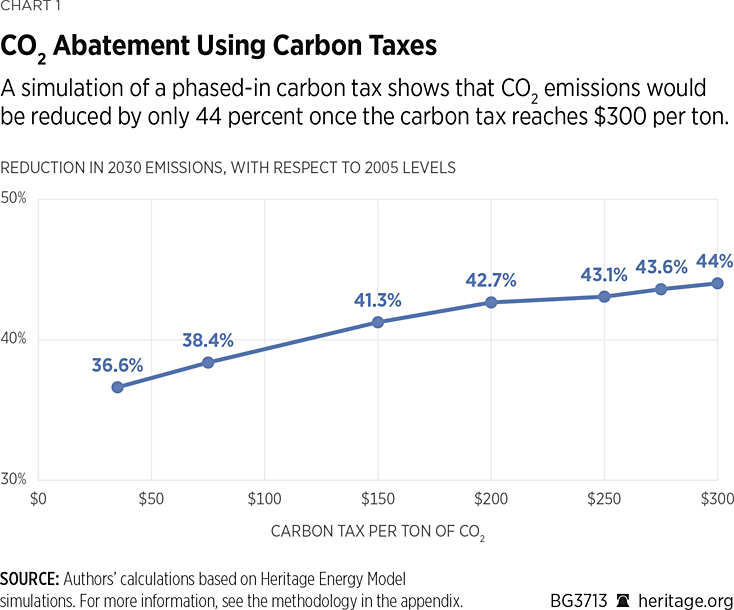
Thus, although the $300 tax appears to be the upper limit of carbon taxes that NEMS can currently handle, the economic impacts, contained in Charts 2, 3, and 4, likely underestimate the impact of the Biden Administration’s goals. Our model simulations find that between 2023 and 2040, the U.S. will incur:
- An overall average reduction of more than 1.2 million jobs,
- A peak employment reduction of more than 7.8 million jobs,
- An average annual income loss for a family of four of $5,100,
- A total income loss for a family of four of more than $87,000 over the 18-year time horizon,
- An aggregate GDP loss of over $7.7 trillion over the 18-year time horizon,
- An increase in household electricity expenditures averaging 23 percent per year, and
- An increase in gasoline prices of more than $2 per gallon annually beginning in 2024 (a more than 90 percent increase over current policy).
Charts 2, 3, and 4 present some sector-by-sector employment impacts as well. As is evident, the economic reverberations of re-entry into the Paris Agreement are manifested across the economy, ranging from financial services to telecommunications to various manufacturing industries, among others.
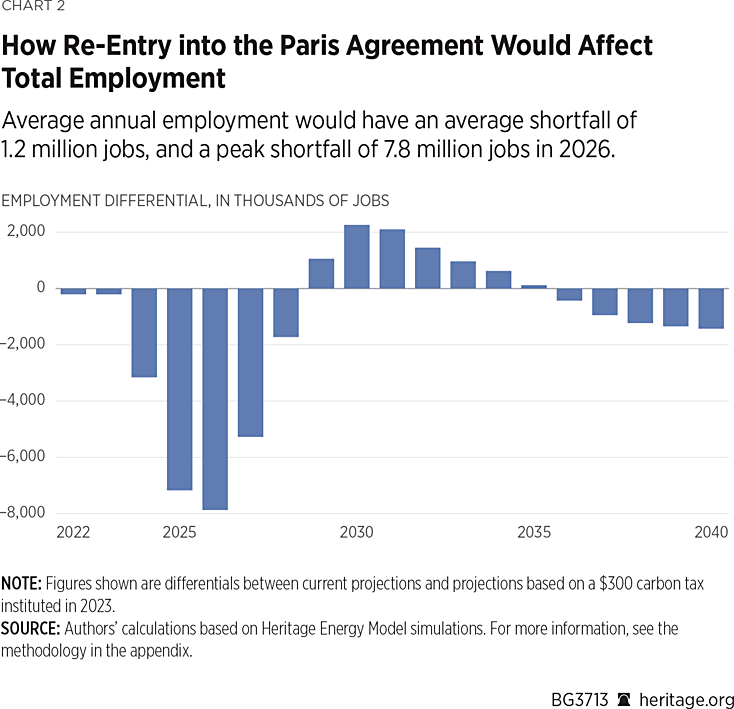
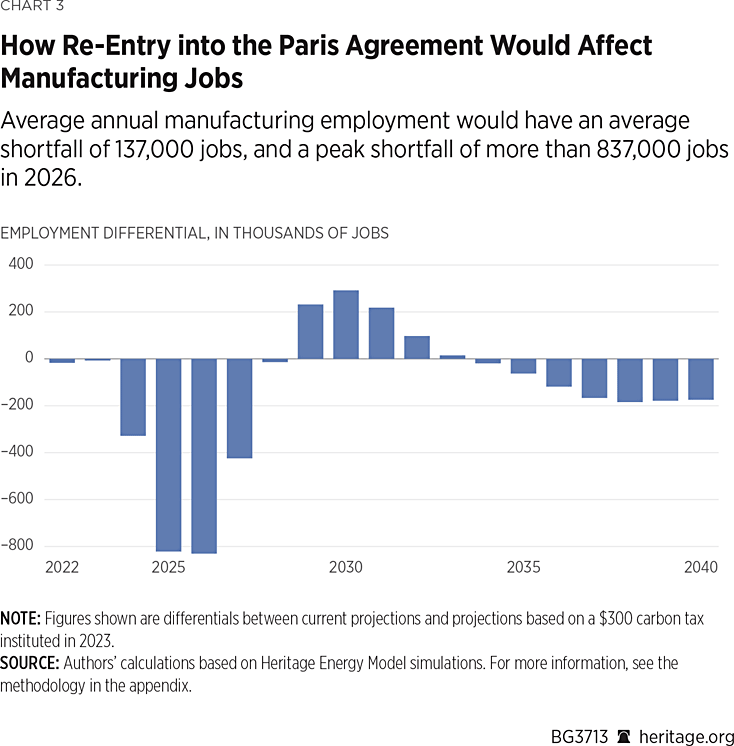
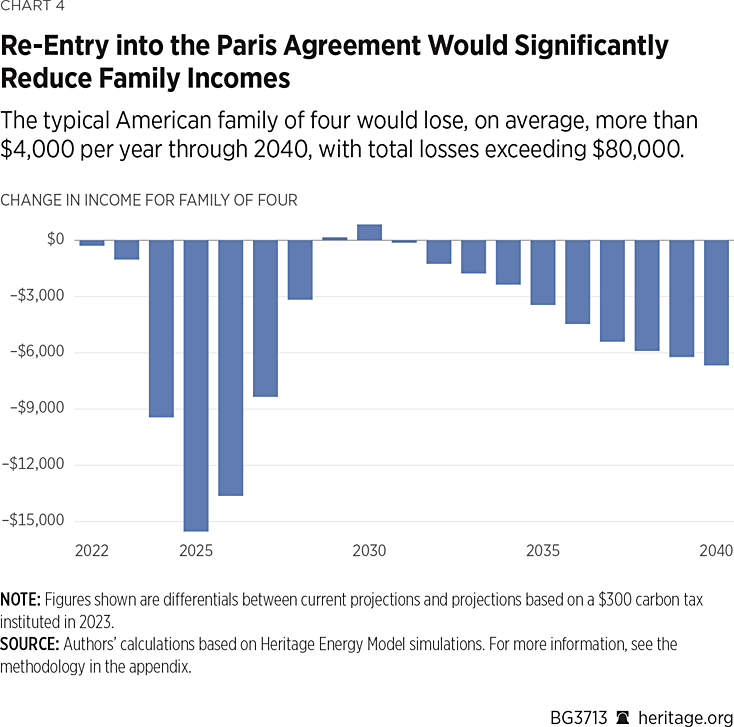
As our analysis demonstrates, the economic impact of re-entry into the Paris Agreement is quite significant. The reason is simple: Energy is a fundamental component of virtually all aspects of society and is essential to countless economic interactions. Conventional, carbon-intensive fuels—coal, oil, and natural gas—meet 79 percent of Americans’ total energy needs.REF Petroleum meets 90 percent of Americans’ transportation fuel needs—energy used by automobiles, trucks, buses, trains, aircraft, and ships.REF Thousands of products are made with oil, coal, and natural gas as feedstocks. Thus, policies that increase energy costs increase costs throughout the economy.
Furthermore, as discussed, the modeled impacts almost surely underestimate the true cost of the Biden Administration’s policy approach to climate change as the modeled policy ($300 carbon tax) would only reduce emissions to 44 percent of 2005 levels in 2030 and to 47 percent in 2040. While in theory a carbon tax would be relatively straightforward in its implementation, the slew of regulations, mandates, and subsidies would impose additional compliance costs, market distortions, litigation, and other economic costs.REF The collective costs of burdensome regulations, cronyist subsidies, and mandates that restrict consumer choice would be fewer jobs, lost household income, and a weaker economy—all without a meaningful climate benefit.
Can the Paris Agreement Mitigate Global Warming?
The Paris Agreement is an ill-suited mechanism to curb warming, even when accepting the dubious premise of catastrophic warming. With no enforcement mechanisms and no repercussions for failing to meet emissions reduction targets, countries can continue to emit GHGs well into the future. According to a November 2019 report from the Universal Ecological Fund, “Of the 184 climate pledges, 36 were deemed sufficient (20 percent), 12 partially sufficient (6 percent), 8 partially insufficient (4 percent) and 128 insufficient (70 percent)” for reaching the emissions reduction targets set out by the agreement.REF
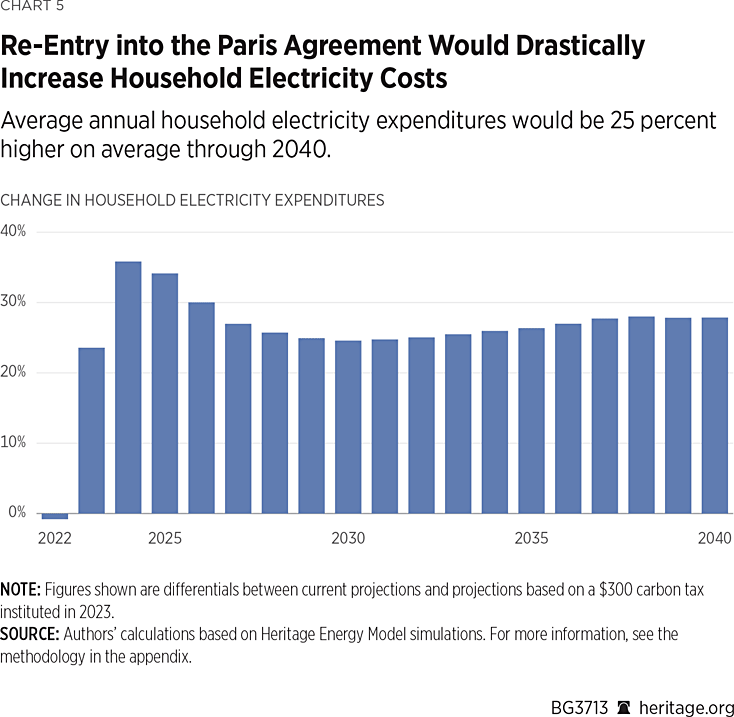
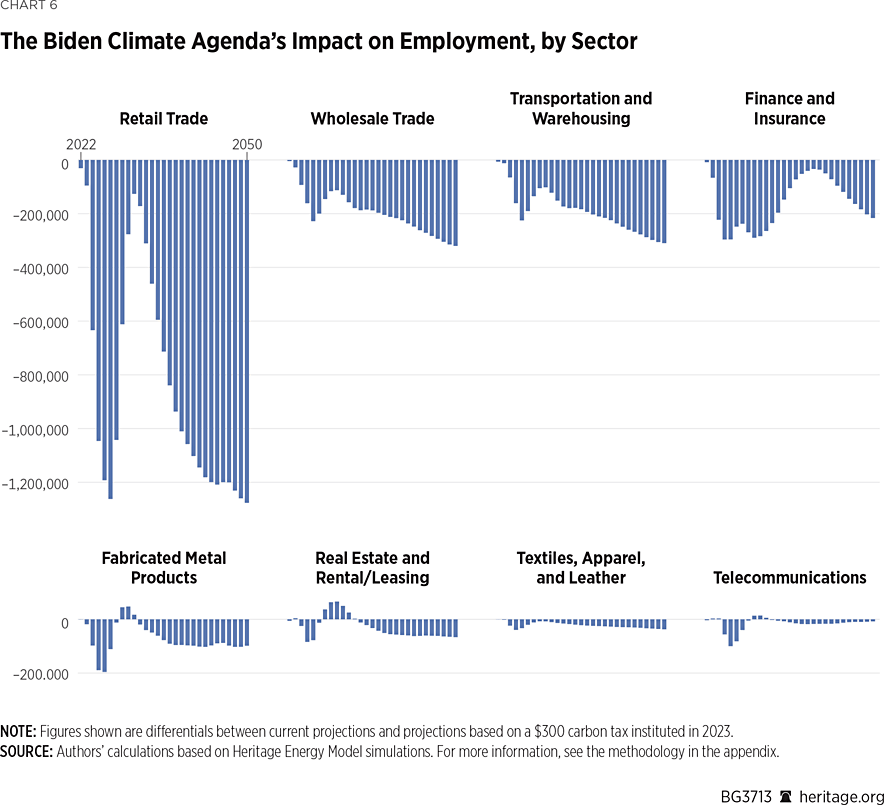
China, for example, is the world’s largest GHG emitter and is allowed to continue to increase emissions through 2030. China’s emissions are more than double those of the United States and more than those of the entire developed world combined.REF China’s total energy consumption has more than tripled since 2000 and it is the world’s top consumer and producer of coal, second for oil consumption, and third for natural gas consumption.REF With per capita energy consumption far below the OECD average, China likely will continue to grow as it looks both to its domestic energy needs and to international energy markets. Consequently, as noted several times by the President’s special climate envoy John Kerry, developed nations could eliminate all GHGs and there would still be no meaningful climate impact.REF
Chart 7 contains a simulation using the Model for the Assessment of Greenhouse Gas Induced Climate Change (MAGICC), developed by researchers at the National Center for Atmospheric Research, that shows the impact of immediately eliminating all U.S. CO2 emissions generated by fossil fuels on global temperatures by the end of the century. In our simulations, we completely eliminated all CO2 emissions from fossil fuels as our alternative scenario and compared temperature forecasts through 2100 to current estimated forecasts in accordance with CO2-emissions trajectories suggested by the Intergovernmental Panel on Climate Change. (For full details, see the appendix.)

Even assuming that the Earth’s temperatures are highly sensitive to GHG emissions, eliminating all U.S. emissions would mitigate global temperatures by less than 0.2 degrees Celsius by 2100. Even if all other OECD economies eliminated GHG emissions as well, the world average temperature increase would be mitigated by no more than 0.5 degrees Celsius in 2100.REF
If there were legally binding targets and enforcement mechanisms, however, it is very likely that countries would not have signed on and ratified the agreement. Energy is essential to peoples’ health, well-being, and economic opportunity and has been a key driver in the dramatic decrease in mortality and extreme poverty over the past century. Consequently, people are reluctant to curb access to energy.REF Perhaps more indicative of the Paris Agreement’s inability to impact global temperatures, then, is its failure to address the growing need for energy around the world.
In 2020, 83 percent of global energy consumption for power, transportation, and heat was met by CO2-emitting energy resources (coal, oil, and natural gas), with the remainder met through a combination of hydropower, renewable energy technologies (including biomass), and nuclear power.REF This percentage has remained roughly unchanged for decades, even as global consumption of energy has increased and renewable energy technologies have entered energy markets.REF The EIA’s International Energy Outlook projects global energy use to increase by 50 percent by 2050, and projects no scenario in which global demand for oil and natural gas do not increase through at least 2050.REF Coal use is expected to decline, but persist as an important source of energy globally.
No one knows what the future holds. (Very few expected the energy boom created by affordable, efficient hydraulic fracking technology.) However, the EIA’s projections provide a more realistic and useful framework for policymakers when thinking about the future.REF
Better Than Paris
As shown, U.S. adherence to the targets of the Paris Agreement provides no more than trivial benefits, if any, and does so at an extraordinarily high cost to average Americans. It is neither reasonable nor laudable to push policies that have real costs to American families and businesses and further erode the American system of limited, representative government for no environmental benefit.
A better approach is the dynamic path that encourages economic freedom and growth. This is the proven path that has made people more prosperous and resilient, characteristics that are necessary for whatever challenges the future holds. History bears out that there is good reason to believe in the creativity of people to solve problems, innovate, adapt, and improve the world around them—and conversely, little reason to trust in the ability of the federal government, much less the combined signatories of the Paris Agreement, to manage an entire overhaul of the energy sector and economy with it. Data from the Index of Economic Freedom over decades clearly show that economic freedom goes hand in hand with economic growth, which is essential to environmental stewardship.REF
Contrary to the assertions of ideologically driven activists, economic freedom has provided real environmental benefits, such as more food from less land, reduced emissions of all sorts, and increasingly efficient technologies. In the past century, extreme poverty—the normal condition for most people and for most of human history—plummeted 80 percent, thanks to economic growth and access to energy.REF Global crop yields of grains increased over 200 percent.REF Deaths from climate-related disasters decreased 96 percent.REF As a percentage of global GDP, damages from natural disasters have declined since 1990.REF Air pollution in the U.S. (not to be confused with GHG emissions) has declined 73 percent since 1980.REF Even assuming the worst to come of global warming, the IPCC estimates that per capita GDP will be $69,000 higher if the world follows a fossil-fuel-development path rather than a “sustainable-development” path even after subtracting damages from global warming.REF In other words, “net-zero” policies are far more damaging than global warming itself.
The choice between a healthy environment and economic growth is a false one. Instead of an agenda that will decrease Americans’ access to energy and cost trillions, President Biden and Congress should pursue a policy agenda that advances economic freedom and rejects symbolic but ineffective climate policies and reduces barriers to innovation and economic opportunity. An environmentally resilient future is one in which Americans are not crushed under the burden of federal debt and regulation, energy is affordable and abundant, and innovators have freedom from cronyism to develop their ideas and export those to the world.
Kevin D. Dayaratna, PhD, is Chief Statistician, Data Scientist, and Senior Research Fellow in the Center for Data Analysis at The Heritage Foundation. Katie Tubb is Research Fellow for Energy and the Environment in the Center for Energy, Climate, and Environment at The Heritage Foundation. David Kreutzer is Senior Economist at the Institute for Energy Research.
Appendix: Methodology
The Heritage Energy Model
The analysis in this Backgrounder uses the Heritage Energy Model (HEM), a clone of the National Energy Model System 2021 Full Release (NEMS).REF NEMS is used by the Energy Information Administration (EIA) in the Department of Energy as well as various nongovernmental organizations for a variety of purposes, including forecasting the effects of energy policy changes on a plethora of leading economic indicators.
The methodologies, assumptions, conclusions, and opinions in this Backgrounder are entirely the work of statisticians and economists in the Center for Data Analysis (CDA) at The Heritage Foundation and have not been endorsed by, and do not necessarily reflect the views of, the developers of NEMS.
HEM is based on well-established economic theory as well as historical data and contains a variety of modules that interact with each other for long-term forecasting. In particular, HEM focuses on the interactions among
- The supply, conversion, and demand of energy in its various forms;
- American energy and the overall American economy;
- The American energy market and the world petroleum market; and
- Current production and consumption decisions as well as expectations about the future.REF
These modules are the:
- Macroeconomic Activity Module,REF
- Transportation Demand Module,
- Residential Demand Module,
- Industrial Demand Module,
- Commercial Demand Module,
- Coal Market Module,
- Electricity Market Module,
- Liquid Fuels Market Module,
- Oil and Gas Supply Module,
- Renewable Fuels Module,
- Natural Gas Market Module, and
- International Energy Activity Module.
HEM is identical to the EIA’s NEMS with the exception of the Commercial Demand Module. The Commercial Demand Module makes projections pertaining to commercial floor-space data of pertinent commercial buildings. Other than HEM not having this module, it is identical to NEMS.
Overarching these modules is an Integrating Module, which consistently cycles, iteratively executing and allowing these various modules to interact with each other. Unknown variables that are related, such as a component of a particular module, are grouped together, and a pertinent subsystem of equations and inequalities corresponding to each group is solved via a variety of commonly used numerical analytic techniques, using approximate values for the other unknowns. Once a group’s values are computed, the next group is solved similarly, and the process iterates. After all group values for the current cycle are determined, the next cycle begins. At each particular cycle, a variety of pertinent statistics is obtained.REF HEM provides a number of diagnostic measures, based on differences between cycles, to indicate whether a stable solution has been achieved.
This report uses HEM to analyze the impact of a carbon tax as well as carbon-related regulations on the economy. As illustrated in Chart 1 of this Backgrounder, we modeled $35, $54, $75, $100, $150, and $300 carbon taxes (per ton of carbon). The carbon tax begins in 2023 with half of the specified value per ton of CO2, doubles to its full value the following year, and increases annually by 2.5 percent each year thereafter. In our simulations, we rebated the revenue collected from the tax back to consumers in a deficit-neutral manner.
The Model for the Assessment of Greenhouse Gas Induced Climate Change
The analysis in this Backgrounder also uses the Model for the Assessment of Greenhouse Gas Induced Climate Change (MAGICC) version 6.REF The MAGICC model quantifies the relationship between atmospheric radiative forcing, oceanic heat content, and surface temperature perturbation via the following relationship:
$$\Delta Q_G = \lambda {_G}{_\square} \Delta T_G + {dH\over dt},$$
where \(Δ Q_G\) is the global-mean radiative forcing at the top of the troposphere. This extra energy influx is decomposed into increased outgoing energy flux and heat content changes in the ocean via the derivative \({dH\over dt}\) . The outgoing energy flux is related to the global-mean feedback factor \(λ_G\) as well as surface temperature perturbation \(ΔT_G\).
Climate sensitivity, denoted in the MAGICC model as \(ΔT_2x\), is defined as the equilibrium global-mean warming after a doubling of carbon-dioxide concentrations and specified via a reciprocal relationship to a feedback factor \(λ\):
$$\Delta T_2{_x} = {\Delta Q_2{_x}\over \lambda}.$$
In the above equation, \(ΔT_2x\) represents the climate sensitivity and \(ΔQ_2x\) represents the radiative forcing following a doubling of carbon-dioxide concentrations. The time or state-dependent effective climate sensitivity \(S^t\) is defined by combining the above two equations as follows:
$$S^t = {\Delta Q_2{_x}\over \lambda^t} = \Delta Q_2{_x} {\Delta T^t_G\over \Delta Q^t - {dH\over dt}|^t},$$
where \(ΔQ_2x\) represents the model-specific forcing for doubled carbon-dioxide concentration, \(λ_t\) represents the time-specific feedback factor, \(ΔQ^t\) represents the radiative forcing, \(ΔT_G^t\) represents the global-mean temperature perturbation, and \({dH\over dt} |^t\) represents the climate system’s heat uptake at time \(t\).
MAGICC also contains a carbon-cycle model that incorporates temperature feedback effects. One of the a priori specifications pertaining to this model is a greenhouse gas emissions trajectory. We assumed trajectories specified in the model based on the most recent Intergovernmental Panel on Climate Change Assessment Reports (IPCC). In our simulations, we used and modified Representative Concentration Pathway 6.0 (RCP6), provided as a potential baseline scenario with the model and specified in the IPCC’s Fifth Assessment Report.REF
Using data from the Environmental Protection Agency, we found that the United States emitted approximately 43 percent of carbon-dioxide emissions with respect to all Organization for Economic Co-operation and Development (OECD) member nations.REF In our simulations, we altered OECD projections accordingly assuming this fraction to be constant over time. Subsequently, we modified RCP6 by completely eliminating carbon-dioxide emissions from fossil fuels in the United States, and separately, all OECD countries, beginning in 2020. Our results thus overstate the estimated temperature impact of the suggested GHG reduction policy.REF In the simulations presented in Chart 5, we assumed climate sensitivities between 1.5 and 4.5 degrees Celsius, the stated acceptable range of the IPCC’s Fifth Assessment Report and encompassing the “high confidence range” in the IPCC’s Sixth Assessment Report.REF




